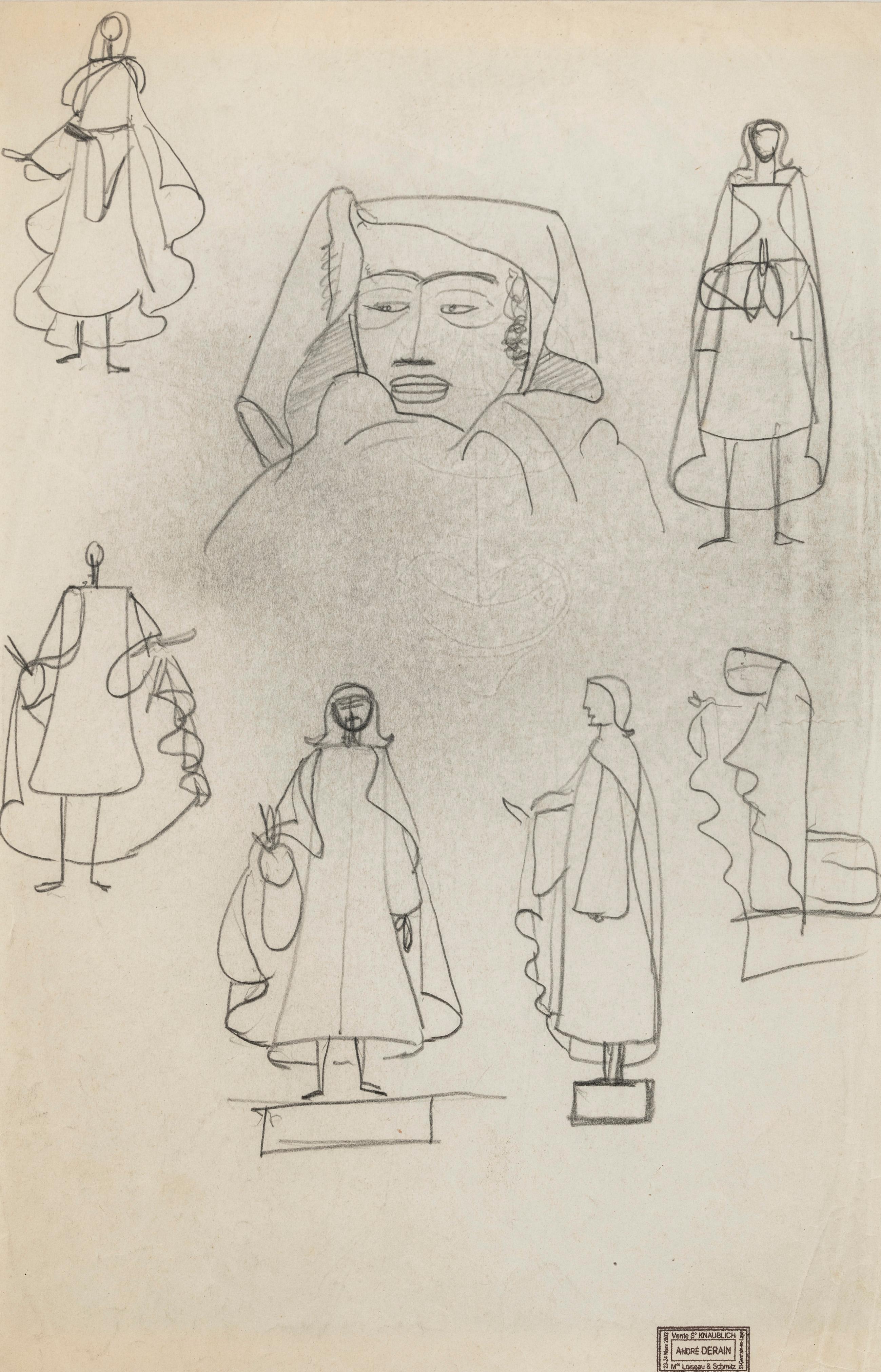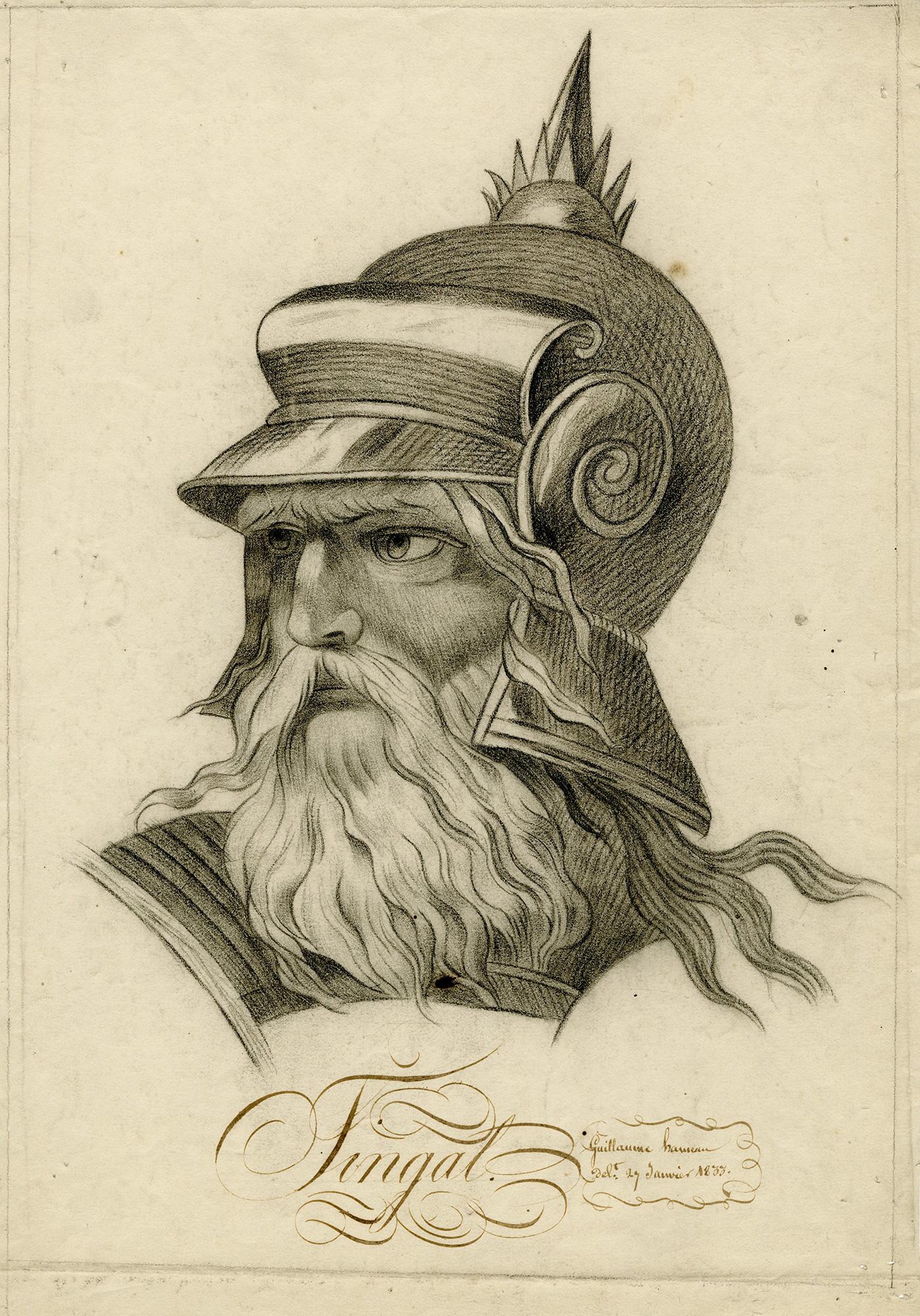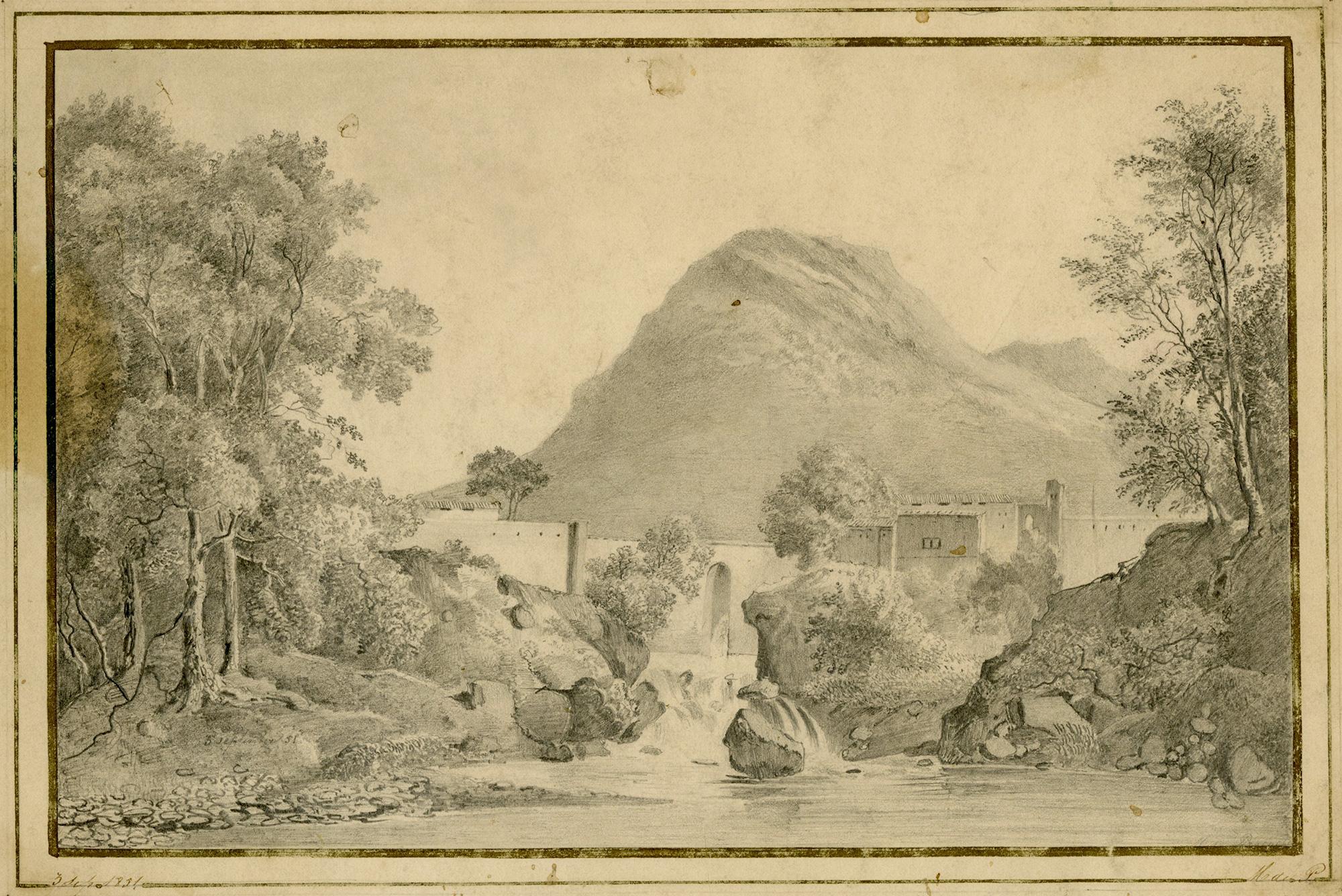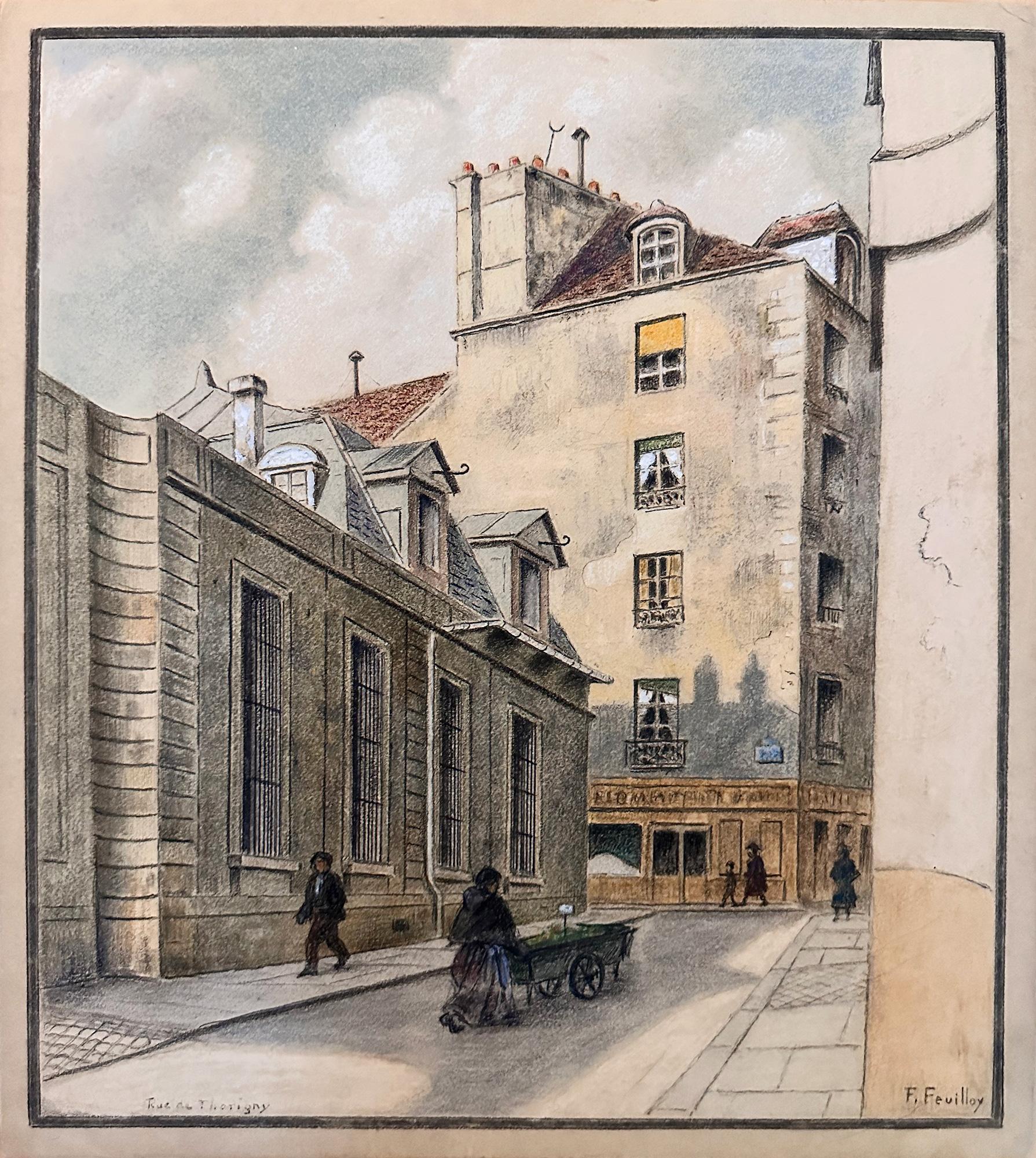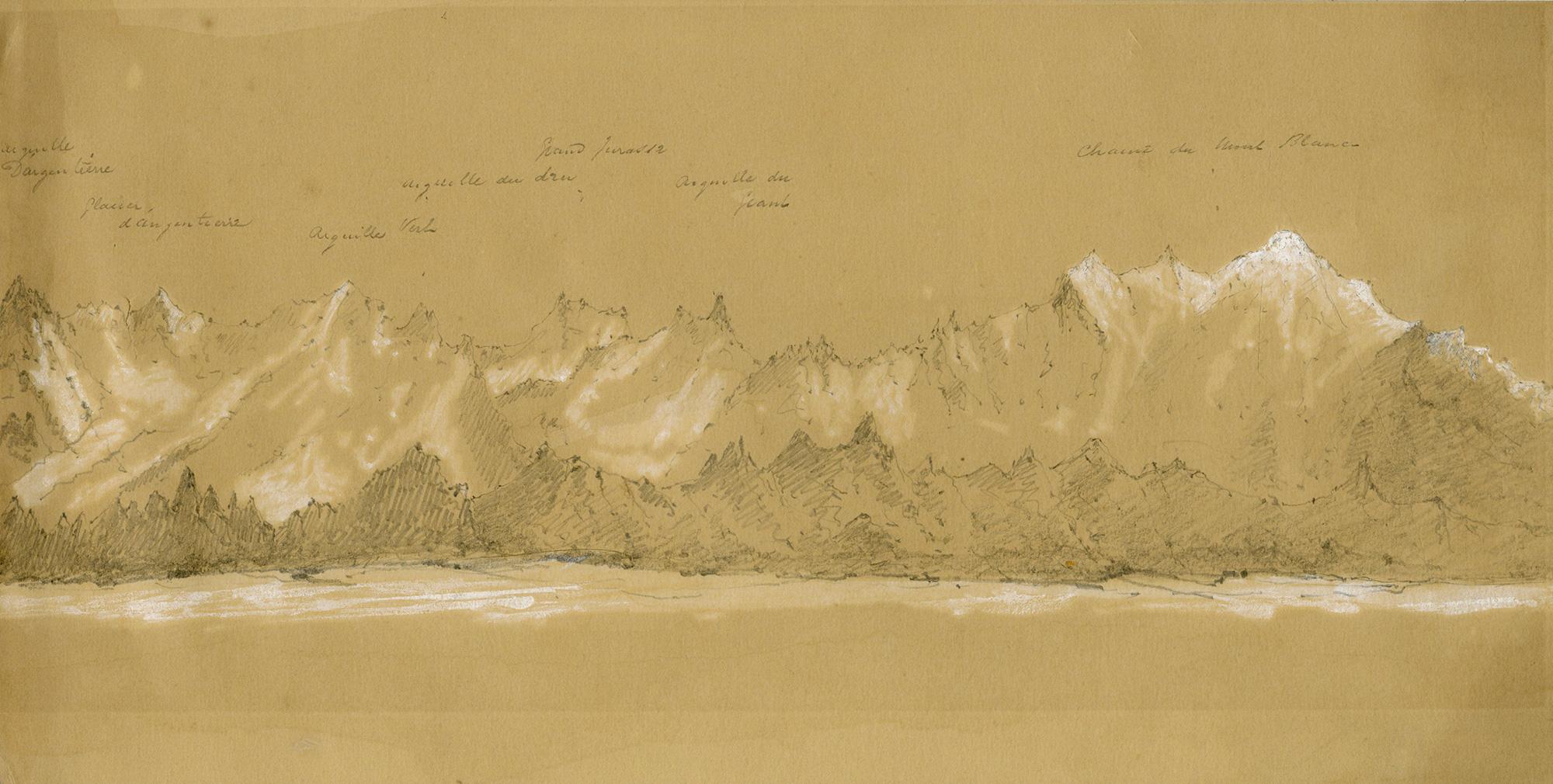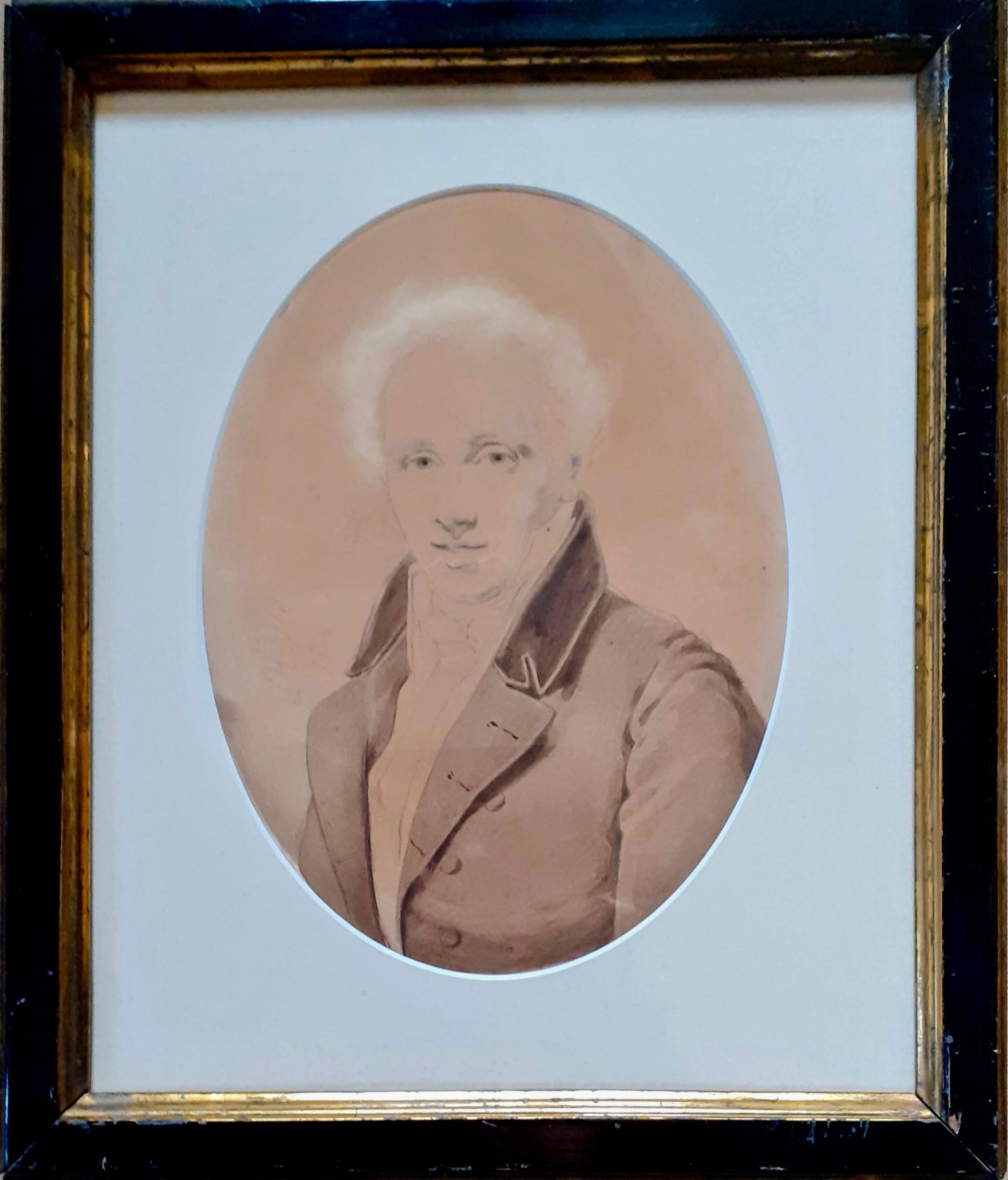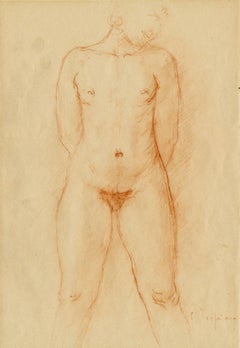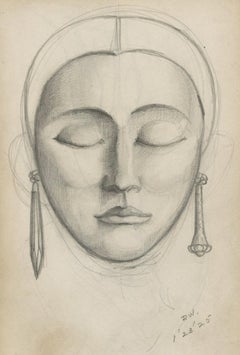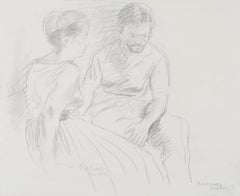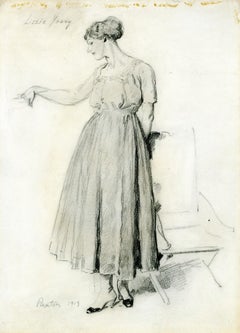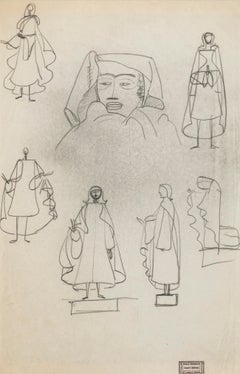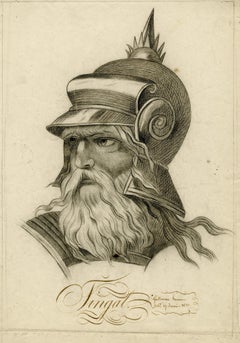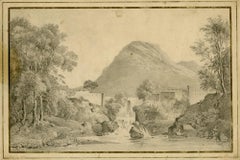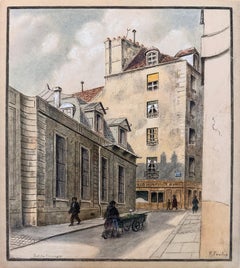Objekte ähnlich wie Untitled (Standing man with umbrella behind)
Möchten Sie mehr Bilder oder Videos?
Zusätzliche Bilder oder Videos von dem*der Anbieter*in anfordern
1 von 5
Charles MaurinUntitled (Standing man with umbrella behind)c. 1890
c. 1890
Angaben zum Objekt
Untitled (Standing man with umbrella behind)
Graphite on paper, c. 1890's
Unsigned
Provenance: Estate of the Artist
Lucien Goldschmidt (1912-1992), noted art
dealer and scholar on Maurin
From the artist's sketchbook/record book, with the typeface number "561"
Image size: 7 7/8 x 6 1/4 inches
Condition: Good, tipped to support sheet
Charles Maurin
le puy-en-velay 1856 - grasse 1914
Biography
Having won the art scholarship known as the Prix Crozatier in 1875, Charles Maurin entered the Ecole des Beaux-Arts in Paris, studying with Jules Lefèbvre and Gustave Boulanger, and with Rodolphe Julian at the Académie Julian. He first exhibited at the Salon des Artistes Français in 1882, where he showed a pair of portraits, one of which gained an honourable mention. He continued to exhibit at the Salon des Artistes Français until 1890. He participated in the Salon des Indépendants for the first time in 1887, showing a number of paintings, drawings and engravings that were admired by, among others, Edgar Degas. As an artist, he worked in a variety of styles, the most distinctive being a sort of Symbolism evident in a range of allegorical subjects that he treated.
Maurin had a lifelong interest in the depiction of the female nude, and, like Degas and Mary Cassatt, was fond of portraying women at intimate moments of their daily routine. He also produced a handful of splendid portraits, mainly in the 1880s and 1890s, of friends, patrons and fellow artists including Georges Seurat and Rupert Carabin, as well as drawings and pastels of café, theatre and street scenes. Around 1885 he took up an appointment as a professor at the Académie Julian, where he met Félix Vallotton, who became a close friend. Another good friend was Henri de Toulouse-Lautrec, with whom Maurin shared an exhibition in 1893 at the Galerie Boussod et Valadon in Paris. It was there that, at the urging of Degas, the collector Henry Laurent began to acquire Maurin’s work, eventually becoming his foremost patron and collector.
The 1890s found Maurin enjoying a moderately successful career, with one-man shows with Ambroise Vollard in 1895 and at Edmond Sagot in 1899. He received a commission from the State for a painting of Maternité (Motherhood); completed in 1893 and sent to the museum in his native town of Le Puy, the painting was soon regarded as one of the artist’s finest works. The previous year he took part in the inaugural Salon de la Rose + Croix, where he showed one of his largest and most important paintings; a monumental triptych entitled L’Aurore (Dawn). He also contributed works to the Salons de la Rose + Croix of 1895 and 1897. Maurin painted a series of large decorative panels of Tragedy, Dance and Music for the foyer of the municipal theatre in Le Puy in 1893, and for Sarah Bernhardt designed sets and costumes for Edmond Rostand’s La Princess Lointaine in 1895. He visited Holland, Belgium and England, and sent works to Le Libre Esthétique in Brussels in 1896 and 1897, and the Exhibition of International Art in London in 1898. A man of firm anarchist leanings, Maurin produced illustrations for the radical journal Le Temps nouveau, and published portrait prints of the French anarchists Louise Michel and François Koenigstein, known as Ravachol. In 1895 he was also commissioned to provide illustrations for the art and literary journal La Revue Blanche.
After 1900, however, Maurin’s output declined considerably, partly due to ill health, and the last years of his life were spent in Brittany and Provence, where he died in obscurity in 1914. His work was largely forgotten after his death, although a retrospective exhibition was held at the Galerie Bernheim-Jeune in Paris in 1921, while a monograph on his work by Ulysse Rouchon was published the following year. Although a significant collection of Maurin’s work is today in the collection of the Musée Crozatier in Le Puy-en-Velay, his paintings and drawings remain little represented in museums outside France.
As a draughtsman, Charles Maurin was equally adept in pastel, chalk and pencil, and was highly regarded by critics, collectors and fellow artists; his drawings were, for example, particularly esteemed by Degas, who compared his draughtsmanship to that of his own great hero, Ingres. An innovative artist, he invented a method of using an atomizer to spray pigment onto the surface of the paper to create what he termed ‘peintures au vaporisateur’; large, atmospheric watercolour landscapes of great subtlety and beauty. Maurin is perhaps best known today, however, as a gifted and prolific printmaker, and played an important role in the revival of colour etching and wood engraving in the 1890s. Like his paintings, many of his prints focus on the female nude, or the theme of mothers and children, and account for some of the artist’s most striking and individual works. Maurin also developed a number of new techniques and processes, particularly with regard to printing in colour. Some of his prints were published in editions of ten or less, however, and much of his graphic work remains very rare today.
Although long forgotten or ignored after his death, Charles Maurin’s eclectic oeuvre as a painter, printmaker and draughtsman remains one of the most distinctive of any artist in France in the late 19th century. The French scholar Jacques Foucart, writing in 1979, succinctly described the artist as ‘that curious and libertarian figure, so typical of the effervescent Paris of the Belle Epoque, an engraver of social customs comparable with Louis Legrand, a perfectionist and an inventive technician, a sensitive draughtsman à la Besnard, a friend of Lautrec and Valloton. He created some of the most extravagant humanitarian and ‘socialist’ visions of the fin-de-siècle, which he treated in a flexible and decorative ‘graphisme’ in the manner of Eugène Grasset, or even of De Feure...That an artist of such intriguing qualities – even though, as engraver of nudes, he does at times become rather tiresomely vulgar and commercial – and so representative of a period that was hungry to explore everything (it is often said that all modern art was contained in the years before 1914), has been the subject of neither an exhibition, since that of 1921 at Bernheim’s, nor of a monograph, certainly sets one thinking about the vagaries of Taste and about the nature of the present fashion for the art of 1900.’ In recent years, however, a revival of interest in Maurin’s remarkable body of work culminated in a major monographic exhibition, entitled Charles Maurin, un Symboliste du Réel, at the Musée Crozatier in the artist’s native town of Le Puy-en-Valey in 2006.
Courtesy Stephen Ongpin, London
- Schöpfer*in:Charles Maurin (1856 - 1914, Französisch)
- Entstehungsjahr:c. 1890
- Maße:Höhe: 20,02 cm (7,88 in)Breite: 15,88 cm (6,25 in)
- Medium:
- Bewegung und Stil:
- Zeitalter:
- Zustand:
- Galeriestandort:Fairlawn, OH
- Referenznummer:Anbieter*in: FA122631stDibs: LU14016413012
Anbieterinformationen
5,0
Anerkannte Anbieter*innen
Diese renommierten Anbieter*innen sind führend in der Branche und repräsentieren die höchste Klasse in Sachen Qualität und Design.
Gold-Anbieter*in
Premium-Anbieter*innen mit einer Bewertung über 4,3 und 24 Stunden Reaktionszeit
Gründungsjahr 1978
1stDibs-Anbieter*in seit 2013
789 Verkäufe auf 1stDibs
Typische Antwortzeit: <1 Stunde
Verbände
International Fine Print Dealers Association
- VersandAngebot wird abgerufen …Versand von: Akron, OH
- Rückgabebedingungen
Einige Inhalte dieser Seite wurden automatisch übersetzt. Daher kann 1stDibs nicht die Richtigkeit der Übersetzungen garantieren. Englisch ist die Standardsprache dieser Website.
Authentizitätsgarantie
Im unwahrscheinlichen Fall eines Problems mit der Echtheit eines Objekts kontaktieren Sie uns bitte innerhalb von 1 Jahr für eine volle Rückerstattung. DetailsGeld-Zurück-Garantie
Wenn Ihr Objekt nicht der Beschreibung entspricht, beim Transport beschädigt wurde oder nicht ankommt, kontaktieren Sie uns bitte innerhalb von 7 Tagen für eine vollständige Rückerstattung. DetailsStornierung innerhalb von 24 Stunden
Sie können Ihren Kauf jederzeit innerhalb von 24 Stunden stornieren, ohne jegliche Gründe dafür angeben zu müssen.Geprüfte Anbieter*innen
Unsere Anbieter*innen unterliegen strengen Dienstleistungs- und Qualitätsstandards, wodurch wir die Seriosität unserer Angebote gewährleisten können.Preisgarantie
Wenn Sie feststellen, dass ein*e Anbieter*in dasselbe Objekt anderswo zu einem niedrigeren Preis anbietet, werden wir den Preis entsprechend anpassen.Zuverlässige weltweite Lieferung
Unsere erstklassigen Versandunternehmen bieten spezielle Versandoptionen weltweit, einschließlich individueller Lieferung.Mehr von diesem*dieser Anbieter*in
Alle anzeigenNu (Stehender weiblicher Akt)
Von Charles Despiau
Nu (Stehender weiblicher Akt)
Rötel auf Velin, um 1925
Signiert unten rechts vom Künstler, siehe Foto
Zustand: Ausgezeichnet
Bild/Blattgröße: 12 1/8 x 8 5/16 Zoll
Anmerkung:
Despi...
Kategorie
1920er, Französische Schule, Aktzeichnungen und -aquarelle
Materialien
Kreide
Kopf einer Deko-Frau (recto) Standendes männliches Modell (verso)
Von Paul H. Winchell
Kopf einer Deko-Frau (recto) Standendes männliches Modell (verso)
Graphit auf Papier, 1925
Signiert mit den Initialen des Künstlers "PW" und datiert 1925
Entstanden während des Stu...
Kategorie
1920er, Art déco, Figurative Zeichnungen und Aquarelle
Materialien
Grafit
Sitzendes Paar
Von Raphael Soyer
Inspiration (Sitzendes Paar)
Graphit auf Papier, ca. 1967
Zweimal mit Bleistift vom Künstler auf der Vorderseite signiert (siehe Fotos)
Zustand: Ausgezeichnet
Bildgröße: 13 x 16 Zoll...
Kategorie
1960er, Amerikanische Moderne, Figurative Zeichnungen und Aquarelle
Materialien
Grafit
Frühe Studie für das Gemälde Rose and Gold, 1913
Von William McGregor Paxton
Frühe Studie für das Gemälde Rose and Gold, 1913
Graphit auf Papier, 1913
Signiert mit Bleistift unten links (siehe Foto)
Mit Bleistift oben links betitelt "Lizzy Young" (siehe Foto)...
Kategorie
1910er, Amerikanischer Impressionismus, Figurative Zeichnungen und Aquar...
Materialien
Grafit
Vorstudie für die Bronzeskulptur Kretische Tänzerin
Von Boris Lovet-Lorski
Vorstudie für die Bronzeskulptur Kretische Tänzerin
Vorzeichenlos
Graphit auf Pauspapier, 1930-1934
Blattgröße: 6 7/8 x 7 1/8 Zoll
Entstanden w...
Kategorie
1930er, Art déco, Figurative Zeichnungen und Aquarelle
Materialien
Grafit
Untitled (Letitia, schwanger mit Sonnenaufgang)
Von Sedrick Huckaby
Untitled (Letitia, schwanger mit Sonnenaufgang)
Graphit auf Papier, 2005
Signiert: "Sedrick Huckaby III" unten rechts (siehe Foto)
Im April 2008 wurde Huckaby mit einem Guggenheim-St...
Kategorie
Anfang der 2000er, Zeitgenössisch, Figurative Zeichnungen und Aquarelle
Materialien
Grafit
Das könnte Ihnen auch gefallen
Männliche Figur und Silhouette Skizzen
Von André Derain
Doppelseitiges Werk in gutem Zustand, Ausbreitung der Knaublich-Sukzession, Loiseau-Shmitz, 23/03/2002. Tampon "Atelier Derain" unten rechts. Ausstellungen:Talismans VI, Galerie Herv...
Kategorie
1940er, Französische Schule, Figurative Zeichnungen und Aquarelle
Materialien
Papier, Grafit
Porträt von Fingal / Finn MacCool - Ein bewegtes Porträt eines irischen literarischen Helden
Schwarze Kreide und Graphit auf leichtem cremefarbenem Velin, 16 1/8 x 11 1/4 Zoll (410 x 286 mm), das ganze Blatt. Signiert, betitelt und datiert in sepiafarbener Tinte im unteren m...
Kategorie
Frühes 19. Jahrhundert, Französische Schule, Porträtzeichnungen und - aq...
Materialien
Büttenpapier, Kreide, Grafit
Landschaft im Berggebirge mit Aquädukt und Damm – FRENCH SCHOOL
Bleistift auf cremefarbenem, glattem Velin mit einer in goldener Tinte gezeichneten Fensterscheibe, 8 3/8 x 11 3/4 Zoll (213 x 298 mm). Unleserlich signiert und datiert in Tinte und ...
Kategorie
Mittleres 19. Jahrhundert, Französische Schule, Landschaftszeichnungen u...
Materialien
Gold
Rue de Thorigny, signiert F. Feuilloy
Graphit und Kreide in Farbe mit weißer Überhöhung auf cremefarbenem Velin, 13 1/2 x 12 1/4 Zoll (343 x 310 mm) (Blatt). In gutem Zustand mit gleichmäßiger Tonung, Handhabungsfalten u...
Kategorie
Spätes 19. Jahrhundert, Französische Schule, Landschaftszeichnungen und ...
Materialien
Buntstift, Büttenpapier, Grafit
Chaîne de Aravais (Gebirge in den Alpen) - Französische Schule, Zeichnung, um 1850
Eine schöne Zeichnung der Aravis-Gebirgskette in den Alpen, einschließlich des Mont Blanc, mit allen von Hand gekennzeichneten Gipfeln.
CIRCA 1850
Graphit mit weißer Überhöhung auf l...
Kategorie
Mittleres 19. Jahrhundert, Französische Schule, Landschaftszeichnungen u...
Materialien
Pappe, Buntstift, Grafit
Porträt eines Gentleman in einem Rotingote von Student od Jean Louis David, Zeichnung
Ein außergewöhnliches Porträt eines Herrn in Tusche, Lavierung und Graphit von Henri-Joseph Hesse aus der Zeit der bourbonischen Restauration in Frankreich um 1820. Es zeigt eine sch...
Kategorie
Frühes 19. Jahrhundert, Französische Schule, Porträtzeichnungen und - aq...
Materialien
Papier, Tinte, Grafit
